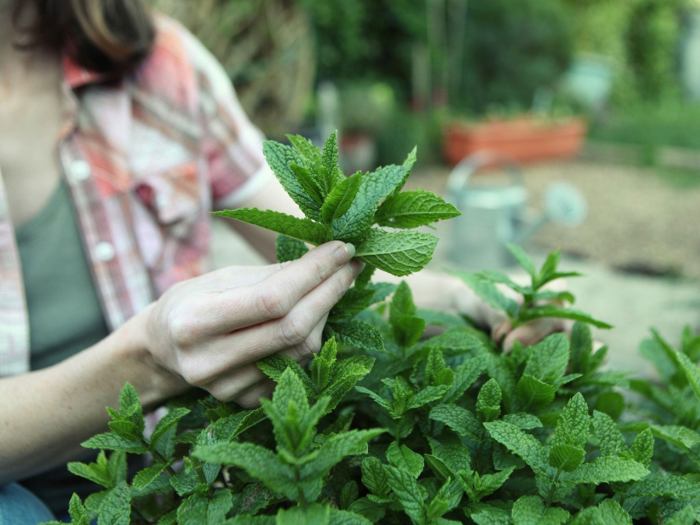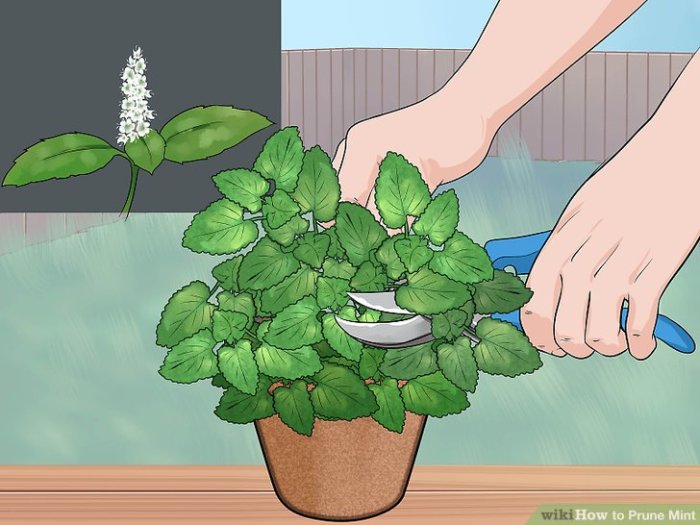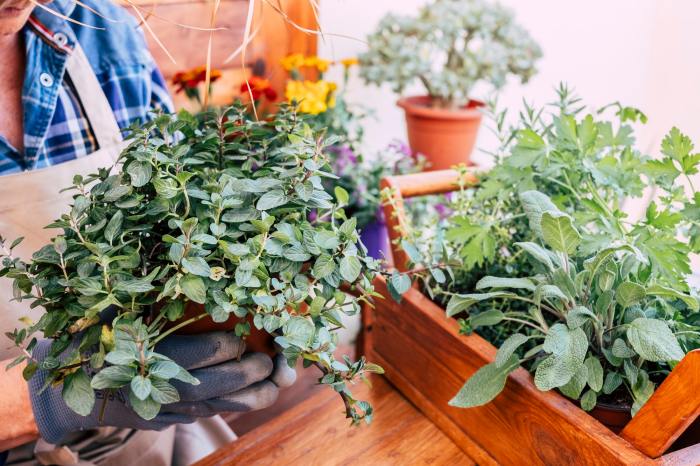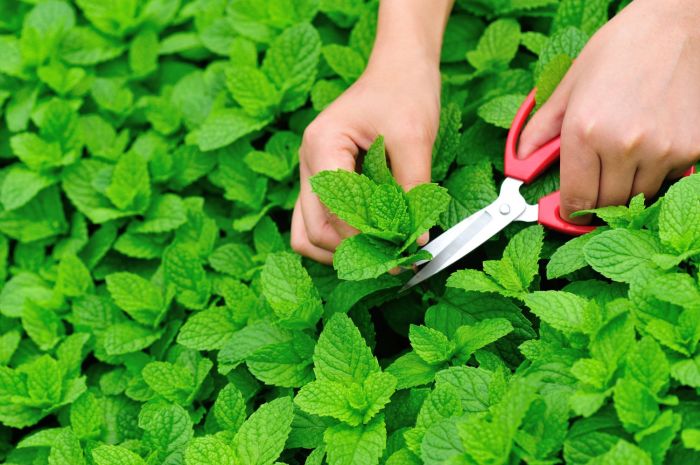How to prune mint plants in pots – Discover the art of pruning mint plants in pots, a simple yet effective technique that promotes optimal growth and enhances the overall health of these aromatic herbs. Whether you’re a seasoned gardener or a novice enthusiast, this guide will equip you with the knowledge and skills to nurture thriving mint plants in the confines of your pots.
Dive into the intricacies of various pruning techniques, including pinching, shearing, and cutting back, and learn how to determine the ideal time for pruning based on climate and plant maturity. Create a tailored pruning schedule that caters to the unique needs of your mint plants and ensure proper post-pruning care to support their recovery and continued growth.
Techniques for Pruning Mint in Pots
Pruning mint plants in pots is essential for maintaining their health, promoting new growth, and controlling their size. Various techniques can be employed, each with its advantages and disadvantages. Understanding these techniques and their proper application is crucial for successful mint cultivation in containers.
Pinching
Pinching involves removing the growing tips of mint stems using your fingers or sharp scissors. This encourages lateral branching, resulting in a bushier plant with increased leaf production. Pinching is a gentle method that can be performed regularly without causing significant stress to the plant.
Shearing
Shearing is a more drastic pruning technique that involves cutting back the entire plant to a desired height. This method is often used to rejuvenate overgrown or leggy mint plants. While shearing promotes new growth, it can temporarily reduce the plant’s productivity.
Cutting Back
Cutting back is similar to shearing but involves removing only a portion of the stems, usually the oldest or weakest ones. This technique allows for more selective pruning, targeting specific areas of the plant that need attention. Cutting back can promote new growth and improve air circulation within the pot.
Determining the Optimal Time for Pruning: How To Prune Mint Plants In Pots

Pruning mint plants in pots should be done at the right time to promote healthy growth and prevent damage. The ideal time to prune mint is in the early spring, just before new growth begins. This allows the plant to focus its energy on producing new shoots and leaves, rather than on repairing damaged ones.However,
the optimal pruning time can vary depending on the climate and the maturity of the plant. In warmer climates, mint can be pruned more frequently, while in colder climates, it is best to prune less often. Additionally, mature mint plants may need to be pruned more heavily than younger plants.To
When pruning mint plants in pots, use sharp, clean shears to remove spent or yellowed leaves. To encourage new growth, pinch back the tips of stems. For a bushier plant, prune regularly throughout the growing season. Similarly, pruning tomato plants in the UK involves removing suckers, yellowing leaves, and diseased foliage.
This encourages air circulation, prevents disease, and increases fruit production. Follow the guide on how to prune tomato plants uk for more detailed instructions. Continue pruning mint plants in pots to maintain their health and vigor.
determine if your mint plant needs pruning, inspect the stems and leaves. If the stems are long and leggy, or if the leaves are yellowing or wilting, it is likely time to prune. Pruning will help to remove dead or damaged growth and encourage new growth.
Creating a Pruning Schedule

A well-defined pruning schedule is essential for maintaining healthy mint plants in pots and ensuring optimal growth and productivity.
Frequency and Intensity:
- Regular Pruning:Prune mint plants regularly throughout the growing season, approximately every 4-6 weeks.
- Intensity:The intensity of pruning should be moderate, removing about one-third to one-half of the plant’s stems.
Adjusting the Schedule:
Adjust the pruning schedule based on individual plant needs and environmental factors.
- Vigorous Growth:If the plant is growing rapidly, increase the frequency of pruning to every 3-4 weeks.
- Slower Growth:For slower-growing plants, extend the pruning interval to 6-8 weeks.
- Environmental Conditions:Consider environmental conditions, such as temperature and sunlight, when adjusting the pruning schedule.
Post-Pruning Care
After pruning, mint plants require proper care to promote healthy growth and prevent issues. This includes providing adequate nutrients, hydration, and support.
Fertilizing, How to prune mint plants in pots
Fertilize the mint plant with a balanced, water-soluble fertilizer. Apply it according to the manufacturer’s instructions, usually every 2-4 weeks during the growing season. This provides essential nutrients for optimal growth.
Watering
Water the mint plant regularly, especially during hot, dry weather. Ensure the soil remains moist but not waterlogged. Overwatering can lead to root rot, while underwatering can stress the plant.
Support
If the mint plant becomes top-heavy after pruning, provide support with stakes or cages. This prevents the stems from bending or breaking under the weight of new growth.
Potential Issues
After pruning, mint plants may experience issues such as:
Yellowing leaves
This indicates overwatering or nutrient deficiency. Adjust watering frequency or fertilize as needed.
When pruning mint plants in pots, it’s important to avoid over-pruning, as this can damage the plant. For best results, follow the tips provided in the guide how to trim mint plant without killing it . By following these guidelines, you can keep your mint plants healthy and productive while ensuring they don’t become overgrown.
Brown spots
These may be caused by sunburn or pests. Protect the plant from excessive sunlight and treat any infestations promptly.
Stunted growth
This can occur due to over-pruning or lack of nutrients. Prune moderately and fertilize regularly to promote healthy growth.
To prune mint plants in pots, start by removing any dead or damaged leaves. Then, use sharp shears to cut back the stems to about 6 inches above the soil line. This will encourage new growth and keep the plant healthy.
For more tips on trimming plants, see our article on how to trim bonsai plants . Once you’ve trimmed your mint plant, water it well and place it in a sunny location. With proper care, your mint plant will thrive and provide you with fresh herbs for months to come.
Designing an Illustrated Guide to Pruning Mint in Pots

To create an effective illustrated guide to pruning mint in pots, follow these guidelines:
Creating an Organized and Visually Appealing Guide
Use HTML tables to organize the guide, making it easy for readers to navigate and understand the pruning techniques.
Including Clear and Detailed Illustrations
Incorporate clear and detailed illustrations to demonstrate the pruning techniques. These illustrations should be visually appealing and provide step-by-step guidance.
Providing Concise and Informative Captions
Accompany each illustration with concise and informative captions that explain the pruning technique being demonstrated.
End of Discussion

Mastering the art of pruning mint plants in pots empowers you to cultivate vibrant and productive herbs that will add freshness and flavor to your culinary creations. By following the comprehensive guidance Artikeld in this article, you can maintain healthy, lush mint plants that will thrive in your potted environment, providing you with a continuous supply of aromatic leaves for years to come.
General Inquiries
How often should I prune my mint plant in a pot?
The frequency of pruning depends on the growth rate of your mint plant. As a general rule, prune back by about one-third of the plant’s height every 4-6 weeks during the growing season.
What is the best time to prune mint plants in pots?
The ideal time to prune mint plants in pots is in the spring or early summer, before the plant starts to flower. Pruning at this time encourages bushier growth and prevents the plant from becoming leggy.
Can I prune my mint plant in the fall or winter?
It is not recommended to prune mint plants heavily in the fall or winter. Light pruning to remove dead or damaged leaves is acceptable, but avoid cutting back the plant by more than one-third.